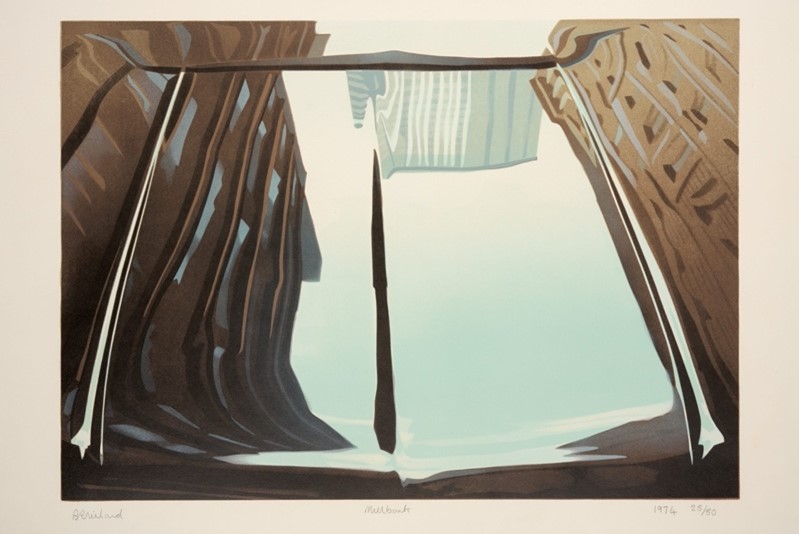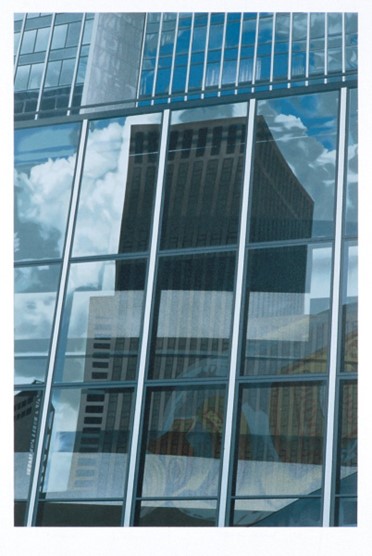During the pandemic, the Art Collection was successful in acquiring two new prints from the Derbyshire SLS (School Library Service) deaccessioning scheme, co-ordinated by Buxton Museum & Art Gallery. We received works by artists Brendan Neiland and Michael Stokoe, complimenting prints we already held by them. The works add to our modest but strong collection of regional printmaking. Art Collection Intern Cami O’Hagan finds out more about the artists & their work below.
Celebrating British Printmaking: The Art Collection acquires works by Brendan Neiland and Michael Stokoe
Art Collection Intern Cami O’Hagan reflects on the Collection’s recent acquisitions and influential lives and work of these contemporary post-war artists, while also uncovering some interesting visuals.
Cityscape (1981) by Brendan Neiland and Wave Under Nine (1969) by Michael Stokoe were originally part of the Derbyshire School Library Service, which closed in 2018 and had to re-home over 2000 items. Now given a new home in Salford, taking into consideration the earlier selection history of British painting, photography and printmaking these artworks are ideal additions to the Collection’s ever-growing printmaking strand.
Both Neiland and Stokoe have had impressive careers, spanning over five decades through many era’s within British history – these culture changes I believe can be seen through the aesthetic shifts in different artwork series by each artist. Predominantly producing through the creative avenues of painting and printmaking, these two artworks showcase a small portion of Neiland and Stokoe’s remarkable and dedicated craftmanship within the sub-medium of screen printing.
Brendan Neiland
Born in 1941 Lichfield, Staffordshire – in 1962 Neiland studied at Birmingham College of Art until 1966 where he then moved to London to embark on his academic journey at the Royal College of Art, as stated in a Q&A session with Brook Gallery this is where he developed his famous spray gun technique. (Brook Gallery & Neiland, 2015)
Widely known for his paintings and screen prints of the modern metropolitan architecture. In Millbank (1974) – one of Neiland’s earlier screen prints first acquired by the Art Collection, this piece measuring 96 x 77cm highlight’s the artist’s signature aesthetic in capturing reflections and refractions of high-rise buildings, giving a new dimension of reality to his viewers.
Cityscape, much like Millbank is a large screen print showing the complexity of urban spaces through mirrored glass, informed by a grid-like frame – I believe this print highlights the influence of photography and lighting within Neiland’s process. The intricate details in playing with the light and shadow within the mirrored glass of these buildings for example, in the lower right corner there is a Gordon’s gin bottle incorporated into the reflection of the building. In my opinion, this is Neiland’s approach to including an element of popular culture into his artwork, possibly hinting at the nation’s favourite alcoholic beverage in the 1980’s?
Neiland’s approach to documenting the essence of the city landscape has prompted me view these large megastructures through a different lens. By including building structures that many often perceive as harsh and rigid, Neiland’s choice of framing and light colour tones adds a softness to the artworks – creating space for the overlooked aspects of city life.



Michael Stokoe (1933-2021)
Michael Stokoe was born in London, 1933. He studied at St. Martins School of Art from 1953-57 where he was exposed to and influenced by the post-war British Art scene, and the rise of modernism. Stokoe had a profuse career, he worked in the marketing and advertising industry after finishing his education. Alongside working in marketing and advertising, for over thirty years he taught at the Ravensbourne College of Art and Design as a senior lecturer.
Having gained major recognition in the earlier half of his career for his pioneering approach to abstraction within his artworks – heavily focusing on geometric shapes, lines and colour. Stokoe’s technical skills and aesthetics have contributed heavily to the Op Art movement. Stokoe’s paintings and prints have been acquired in world renowned collections such as V + A museum, Government Art Collection, United Kingdom and the Bibliotheque Nationale, Paris.
Wave Under Nine is a 48 x 43cm screen print comprising eight perfectly round blue circles and one turquoise oval shaped circle embraced by a deep red background. In the lower section of this print, a line which is curved central to the oval shape which adds an element of movement within the piece. The beige tone reminds me of sand within a desert landscape, the turquoise oval might possibly represent the moon appearing against the red sky just after sunset. It is clear that Stokoe’s primary visual concern is form and colour, the preciseness of the circular shapes in my opinion pushes the viewer to engage with the artwork on a deeper level. Wave Under Nine has encouraged me to think more comprehensively, regarding the infinite possibilities an artist has when exploring colour and form through screen printing, in addition to how we as an audience may view the artwork.
On a final note, reviewing these recent acquisitions has made me reflect on my time as a student at the University of Salford; how within the last three years Manchester and Salford skylines have changed quite drastically. Since starting my degree in 2021 and graduating in July of this year – I have witnessed the birth of new skyscraper apartment towers, new concert arenas and the re-development of historic buildings. Although Cityscape and Wave Under Nine are both disparate regarding the intended visual outcomes, from the mirrored urban landscape to the geometric shapes, and abstract form and colour – to me these artworks symbolise how places/locations can feel or be perceived in a different format.
As someone who also produces through the medium of screen printing, I am compelled to consider how we as artists and practitioners can find the hidden meanings and connections to the external elements of our own personal lives and also within the collective experience. Whether its abstract or landscape art, Neiland and Stokoe’s work in my opinion, should prompt us to think about how our surroundings/landscapes are constantly changing in the North West of England.
By Cami O’Hagan
Reference List
Brook Gallery, & Neiland, B. (2015, October 16). Brendan Neiland Q&A Snippet. YouTube. https://youtu.be/d3F5LnbxMi8?si=O8IOK2LQ0Jz-8qUy